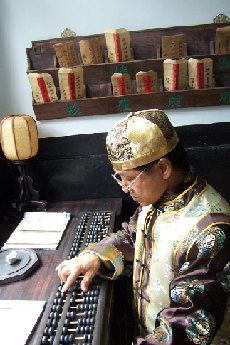
Throughout China's 5,000-year history, business has always been an indispensable vehicle for its social development. When the history wheel entered the Ming (1368-1644) and Qing (1644-1911) dynasties, Chinese guilds,or business associations based on lineages, came into shape.
In the history of Chinese business,guilds are best represented by the merchants of Shanxi,Anhui,Zhejiang, and Guangdong provinces who enjoyed great prosperity throughout several ancient dynasties,when all the elements necessary to sustain a successful economic climate combined in their favor.
Shanxi merchants of the Ming and Qing dynasties, for example, evolved as both the farming culture of the Central Plains and the nomadic culture of the north became more sophisticated.Inevitably,trade between the agricultural and nomadic communities developed quickly, creating an opportunity for the growth of Shanxi merchants.
Situated in the midst of the cradles of these cultures, Shanxi naturally became the indispensable trade link between the two.
Conversely,in feudal imperial time the Chinese commodities economy did not develop along normal entrepreneurial lines.As a result.because the destiny of ancient Chinese guilds was managed according to the imperial stratum,they were unable to avoid decline when the era of monarchy ended.
As the reign of the Shanxi and Anhui merchants came to an end,the businesspeople in Zhejiang and Guangdong who had been active in the southern coastal areas also saw their fortunes fade.
However, by contrast,they did not completely leave the historical stage -- they revived under a strong international focus inShanghaiandGuangzhou,the trade ports opened by Western aggressors at the end of theQing Dynasty, making them the ancestors of China's modern merchants.
Shanxi bankers
The Shanxi merchant group, from a region with a fair share of barren land, achieved commercial fame possibly even earlier than that of the Hui merchants. Their trading routes, more in the North-South direction, extended nationwide and reached Russia through the caravan land-routes. But what brought them unprecedented prosperity was their nationwide money remittance service from the 19th century.
Legend has it that it all started around the 1810s when a paint and dye merchant started China's first piaohao, a banking firm that provided merchants and long-distance travelers with drafts that they could exchange for cash at a specified branch after reaching their destination, thus effectively reducing the cost and risk of carrying bulky metallic cash.
